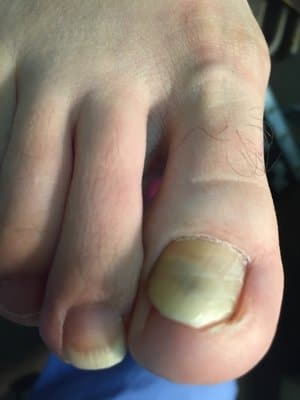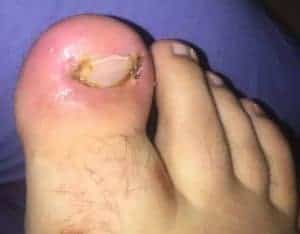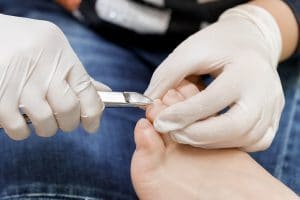
Ingrown Toenail Treatment
 An ingrown toenail is a painful medical condition that can affect anyone regardless of age or other medical conditions. Luckily, there are a variety of treatments that can help repair an ingrown toenail. Do not ignore your infected nail. It is important to pay a visit to a healthcare provider. Only a medical professional can make a complete diagnosis taking into account all pertinent factors including past medical history and underlying conditions. Other medical problems and conditions can resemble the symptoms of an ingrown toenail to an unqualified person. Local trauma, tumors, toe fungus and foreign objects embedded under the skin may look the same but require a different treatment plan. An ingrown toenail is caused when the edge of the toenail bends downward and become imbedded into the skin on the toe. An ingrown toenail can often happen after trimming your toe nail too short or if your shoes are too tight or short.
An ingrown toenail is a painful medical condition that can affect anyone regardless of age or other medical conditions. Luckily, there are a variety of treatments that can help repair an ingrown toenail. Do not ignore your infected nail. It is important to pay a visit to a healthcare provider. Only a medical professional can make a complete diagnosis taking into account all pertinent factors including past medical history and underlying conditions. Other medical problems and conditions can resemble the symptoms of an ingrown toenail to an unqualified person. Local trauma, tumors, toe fungus and foreign objects embedded under the skin may look the same but require a different treatment plan. An ingrown toenail is caused when the edge of the toenail bends downward and become imbedded into the skin on the toe. An ingrown toenail can often happen after trimming your toe nail too short or if your shoes are too tight or short.
Ingrown Toenails: Possible Complications
If an ingrown toenail persists over a long period of time, it can have serious consequences. It is not uncommon to develop a paronychia (localized) infection along the area where the nail edge cuts into the skin. If not treated a paronychia infection can develop into a dangerous deep, soft-tissue infection (called cellulitis), which can further advance into a very serious bone infection (called osteomyelitis).
Complications can additionally include:
- Nail Fold Hypertrophy: Scarring of the skin and nail borders surrounding the site.
- Onychodystrophy: Thickening or deformation of the nail.
- Onychomycosis: Fungal infection of the toenails.
The soft tissue at the site of the nailfold may become enlarged. It will frequently bleed and drain.
Other Complications of Ingrown Toenail Surgery
While not considered a particularly risky procedure, as with all surgery there is a small risk of complications resulting from infected toenails surgeries. They are rare but have been known to occur. Some of the post-surgical complications include:
- infection at the procedure site,
- prolonged discomfort surrounding the site of the procedure,
- a slowly healing wound (especially common in those with diabetes) and
- symptom recurrence.
You are at a higher risk of post-surgery complications if you fail to follow properly the instructions of care for the nail. Luckily, in most cases, these complications can be managed with relative ease. If it’s known that you are prone to infection, your healthcare provider might prescribe a course of oral antibiotics following the procedure.
How To Prevent Ingrown In Future?
1. Trim Your Nails Straight!
Your doctor may have told you that it happened because you didn’t correctly cut your nail the last time you visited for treatment.
Ingrown nails are more likely if your nails are curved, as the curve angle makes it simpler for your nail to grow into the skin.
You may not realize it, but clipping your nails incorrectly can lead to problems such as ingrown toenails. But now is the moment to shift your perspective and begin properly pruning them.
Also, don’t cut them too short because the skin may grow higher than the nail, causing an ingrown nail to reappear or an infection if there isn’t enough coverage.
2. Protect Your Feet
You must have stopped playing your favorite games like soccer if you are hurt or have a persistent ingrown nail, right?
If so, you’re doing fantastic, but keep in mind that you shouldn’t keep performing them until you’re completely recovered.
Running and jumping should also be avoided. They may not appear to be dangerous, but they can cause pain and make it difficult for your ingrown nail to heal.
Avoid any workout that involves putting pressure on your feet or toes.
If you play soccer, make sure to give your feet ample time to heal after each game and get medical attention if you notice any issues.
Selecting a Healthcare Professional to Treat your Ingrown Toenail
Are there specific exercises or stretches to prevent ingrown toenails?
While exercises and stretches can’t directly prevent ingrown toenails, maintaining good foot health and hygiene may reduce the risk. Here are exercises and practices that promote overall foot health:
- Toe Exercises: Gently flex and extend your toes regularly to improve circulation and flexibility.
- Foot Stretches: Stretch your feet and calf muscles to maintain flexibility.
- Proper Toenail Cutting Technique: Cut toenails straight across to prevent ingrown toenails.
- Regular Inspection: Check your feet regularly for signs of ingrown toenails or other issues.
- Wearing Proper Footwear: Choose shoes with sufficient toe room to avoid pressure on the toenails.
How does toenail shape influence the likelihood of ingrown toenails?
Toenail shape plays a significant role in the likelihood of developing ingrown toenails. Certain nail shapes can predispose individuals to this condition. Factors include:
- Curved or Rounded Toenails: Nails that naturally curve or are rounded at the edges may be more prone to growing into the surrounding skin.
- Involuted or Pincer Nails: These nails have a deeper curve and may increase the risk of ingrowth.
- Toenail Width: Wider toenails are less likely to grow into the skin, whereas narrower nails may be more prone to ingrown edges.
- Improper Trimming: Cutting toenails too short or rounding the edges instead of cutting straight across can contribute to ingrown toenails.
Can ingrown toenails be a recurrent issue for some individuals?
Yes, ingrown toenails can be a recurrent issue for some individuals. Factors contributing to recurrent ingrown toenails include:
- Genetics: Predisposition to ingrown toenails can be inherited.
- Nail Shape: Naturally curved or rounded toenails may increase the likelihood of recurrence.
- Improper Nail Cutting: Cutting toenails too short or rounding the edges can lead to recurrence.
- Footwear: Tight or ill-fitting shoes can contribute to repeated ingrown toenail issues.
Can ingrown toenails lead to more severe complications if left untreated?
Yes, ingrown toenails can lead to more severe complications if left untreated. Some potential complications include:
- Infection: One of the most common complications is infection. The skin around the ingrown toenail can become red, swollen, and painful. If bacteria enter the affected area, it may result in a more severe infection.
- Abscess Formation: Prolonged infection can lead to the formation of an abscess, a collection of pus. Abscesses can cause increased pain and may require drainage.
- Cellulitis: Untreated infections can spread and lead to cellulitis, an infection affecting the skin and underlying tissues. Cellulitis can cause redness, warmth, and tenderness beyond the ingrown toenail area.
- Ulceration: Chronic irritation and pressure from the ingrown toenail can lead to ulceration, open sores on the skin. Ulceration increases the risk of infection.
How does the presence of calluses or corns affect the risk of developing ingrown toenails?
The presence of calluses or corns can affect the risk of developing ingrown toenails in several ways:
1. Increased Pressure: Calluses and corns are areas of thickened skin that often develop in response to repeated pressure or friction. When these areas form on or around the edges of the toenail, they can increase pressure on the nail and the surrounding skin, making it more likely for the nail to grow into the skin and become ingrown.
2. Altered Nail Growth: Calluses and corns can alter the way the toenail grows. If the nail is forced to grow in a curved or irregular manner due to the presence of a callus or corn, it may be more likely to become ingrown.
3. Difficulty Trimming Nails: Calluses and corns can make it more difficult to trim the nails properly. If the nails are not trimmed straight across and are instead trimmed too short or with rounded edges, it can increase the risk of ingrown toenails.
4. Reduced Sensation: In some cases, calluses or corns can reduce sensation in the affected area. This can make it harder for individuals to notice early signs of an ingrown toenail, such as pain or redness, and seek treatment promptly.
Can ingrown toenails be caused by improper nail trimming techniques?
Yes, improper nail trimming techniques are a common cause of ingrown toenails. When toenails are trimmed improperly, such as cutting them too short or rounding the edges instead of trimming them straight across, it can increase the likelihood of the nail growing into the surrounding skin.
Trimming the nails too short can cause the skin to fold over the nail, leading to irritation and potential ingrowth. Rounding the edges of the nails can also encourage the nail to grow into the skin instead of growing straight out.
Most practicing medical professionals are not qualified to treat toenails, they lack proper tools and specific training. Many people may first visit their family physicians, urgent-care walk-in physicians, pediatricians or dermatologists when seeking treatment for an ingrown toenail. With that said, podiatrists are doctors that specialize in the foot and ankle. They are uniquely qualified in the medical community to treat your condition. He or she will likely have much more experience dealing with conditions such as yours, plus a podiatrist’s office will be equipped with all the required instruments necessary to perform a variety of ingrown toenail procedures.

